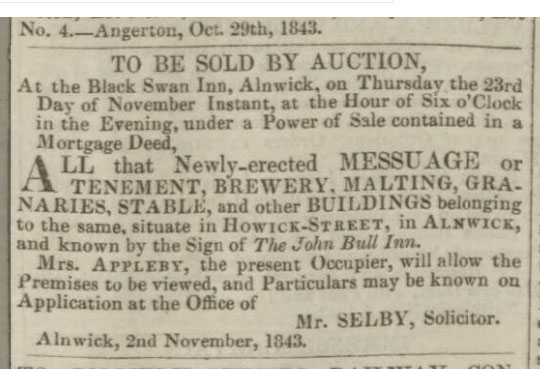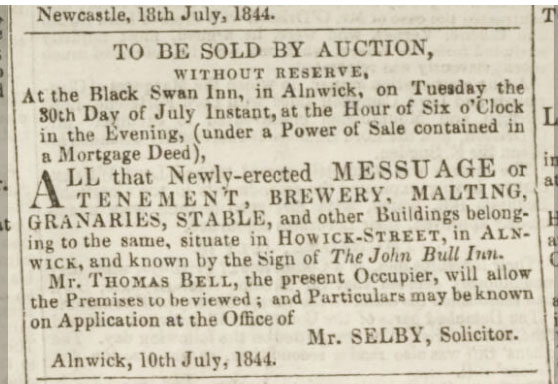History of the John Bull Inn
There has been a public house in Howick Street from as soon as the properties were built in the 1830s but it is not believed to have been called by that name till later – mention is made of the “Star and Garter” in early documents.

Photo courtesy All Set Marketing
The first “retailer of beer” listed in the 1834 Pigot’s directory for this area was John Lumsden in Green Bat. Howick St was called Green Bat Close to begin with.
On the 1841 census for Howick St, no property was designated as a pub, although Robert Gallon age25 was a “publican” living with his wife, Isabella and 3 small children, George, William and John. Jane and Ann Mole were servants. This family had moved away before 1851 and Robert became a blacksmith in Newcastle.
In 1843 the pub, called the John Bull, was up for sale:

It seems that the buyer did not pay their mortgage, as it ws up for sale again the next year, with the “present occupier” being Mr Thomas Bell:

On the 1851 census there was a property designated “The Star and Garter Inn”, where the tenant was William Anderson. He was 69 and lived with his wife Ann 55,daughter Ann a 31 year old staysmaker and two sons William,22 and Charles 19, who were both working as slaters. Mary his 14 year old grand-daughter was the domestic servant.
In the 1855 Whellans directory, John Black was listed as “brewer John Bull Inn”.By 1858 in the Post Office directory for Howick St., Mrs Ann Black was listed for the John Bull Public House.
The 1861 census has Thomas Crawford as the publican at John Bull Inn. He was 50 and lived with his wife Margaret Ann, aged 40 and three daughters, Sarah Ann, 7 Isabella 6 and Elizabeth 4 and a lodger Elizabeth Gelson aged 3. On the same census for Howick St there lived a 51 year old brewer and maltster called John Cook. His wife Margaret was 60, a 31 year old daughter Jane Reay and her two children William, 5, and John ,1 also lived there.
In the 1871 census, William Black was a 61 year old brewer employing one man. (Q Did he occupy the John Bull and not the” Black Bull” as stated?) He lived in Howick St with his wife Alice, 63 and two daughters, Alice 27, and Margaret 18. Further up the road was Margaret Cook, now a widow working as a laundress with her daughter and grandsons, still living with her, John Cook’s, widow.
In 1871 the Pub was used as a Coroner’s court when a local man was found dead on the road.
By 1879 listed as landlord at the John Bull in Kelly’s directory, was John Bruce (Brewis).
By 1887 the Kelly’ directory stated William Graham was the landlord.He was still there at the time of the 1891 census and William was also a wood sawyer. He was 39 by then, as was his wife, Mary. They had 4 children, Mary 10, Jane 7, Dorothy 5 and William 3, and a general servant called Ellen Croft. They had moved on before 1894, when the Kelly’s directory listed Thomas Wellans as the landlord.
By 1901 the “ InnKeeper on own account” was William McNally from Ireland aged 48.His wife Elizabeth was 44 and they had three children, Elizabeth 14, Mary 12, and Joseph G aged 10.
In 1911, more information was included on the census form. It states that Thomas Redford Ternent was the licensed Victualler. He had been married to his wife Annie for 11 years and had one child Ellen A W Ternent aged 10. Thomas also had his father-in-law 54, who was a moulder in the iron foundry. This Adam Walkenshaw also had with him, his son Charles a 24 year old stone mason, daughter Margaret a 19 year old general servant in the pub, son Alexander a 17 year old hairdresser, and daughter Elizabeth aged 16 and also a general servant. This extended family had 3 rooms to live in.
Thomas Redford Ternent was still there in 1921 in the Kelly’s directory. From Thomas’ original deeds and mortgage information, he became the new owner of the premises on 22/10/1920, so must have been the tenant land lord before that*. He took out a mortgage from two brothers from South Shields, Robert Fenwick Brigham and Malcolm Cowan Brigham.
*On 7/2/1888 an indenture of mortgage had been drawn up between George Stott Smart “the vendor” and Matilda Tate Thompson and Elizabeth Anna Maria Percy where each paid the sum of £1,600 and £1,400 with interest as tenants.
A Tale of Debauchery from 1877
Pub landlords have always been held responsible for the good behaviour of their clientele, as this clipping shows. How many customers go in and ask for a “gallon of ale” nowadays, one wonders!
.jpg)
Alnwick Mercury 13th January 1877

